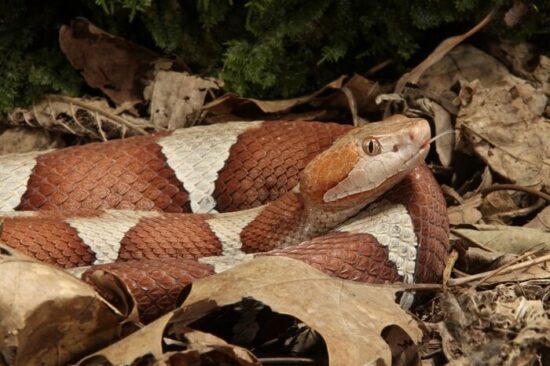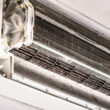Copperhead snakes are common reptiles that invade yards and homes regularly. However, many people have no clue how to deal with them!
This guide will teach you how to get rid of copperhead snakes and keep them away for good!
Table of contents
What Are Copperhead Snakes?
The copperhead snake is a common backyard pest that many homeowners want to get rid of. This snake species is a member of the viper family and has the potential to deliver a painful bite.
A medium-sized reptile, copperheads grow to lengths of about two or three feet. Longer female snakes can reach sizes of about 40 inches at most. Much thicker than your garden-variety garter snake, copperhead snakes are pretty easy to identify. If you don’t recognize them by their shape, you’ll undoubtedly notice the signature color.
The back of the snake is usually tan or light brown. Adding to the base color are dark, irregular bands of reddish-bronze. The color combination creates an effective camouflage the snake can use to blend into its surroundings.
The head is probably one of the snake’s most signature traits. It’s triangular in shape and takes on a distinct copper color. That’s how the copperhead snake gets its name!
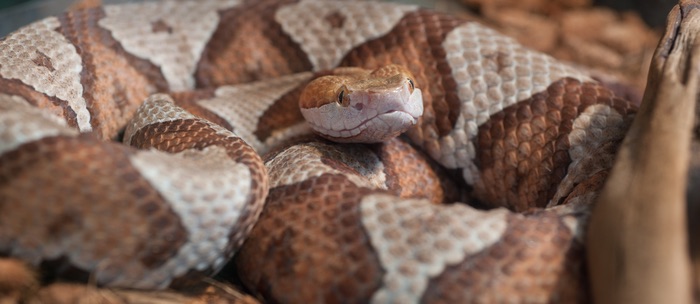
Quick Tip: Juveniles look pretty similar to adults. The main difference is the overall size and bright yellow tail to attract prey.
Copperheads are widespread throughout the eastern seaboard. They can invade backyards as far south as the Florida Panhandle and Massachusetts to the north. They can also appear in states as far west as Nebraska.
Are They Dangerous?
Copperhead snakes are one of the most feared pests, and there’s a good reason for that.
These snakes are venomous. They deliver a haemotoxic poison that has the potential to cause tissue damage.
Copperhead snakes are reportedly responsible for more snake bites than any other species in the United States. They’re masters of evasion and often go unnoticed until they’re disturbed.
The good news? Copperhead snakes rarely kill people. The snake’s venom can cause fatalities, which children, older adults, and pets have the highest risks. However, they deliver so little venom in each bite that most people can make a full recovery with proper treatment.
For this reason, they’re not as dangerous as other venomous snakes. America’s other venomous species (rattlesnakes and cottonmouths) are more likely to cause death and severe injury.
While copperheads can bite, they’re not considered aggressive. These snakes would much rather stay hidden or flee in the presence of danger. In most cases, they only resort to biting when they feel threatened.
Quick Tip: Unlike other snakes, copperhead snakes don’t provide much warning before a bite. As a result, attacks are swift and to the point! Fortunately, they don’t occur very often unless you frighten or provoke them.
Where To Find Them In Your Yard
These snakes can thrive in a wide range of environments. From marshy areas near water to dry pastures, copperheads readily adapt to what’s available.
That said, they do have some preferences. Copperheads almost always stick to areas that offer plenty of coverage and protection. They love tall grasses that they can slink through without being detected.
For nesting areas, you might spot these snakes living in wooded areas with plenty of debris. Mulch, leaf litter, and rotted wood piles offer the perfect hiding spot to nest.
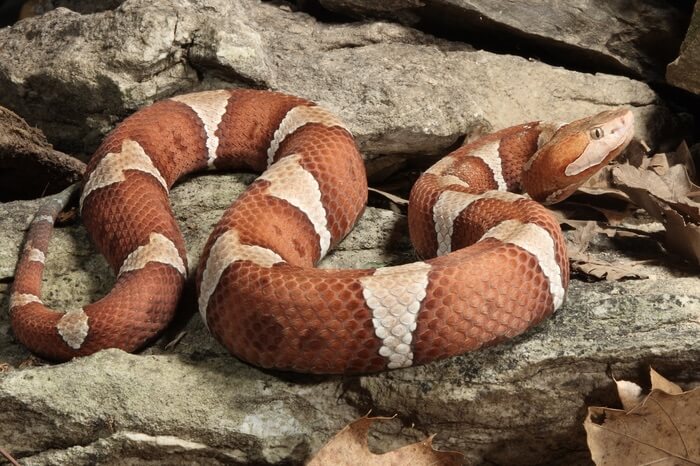
In heavily populated areas, copperhead snakes tend to stay near the exterior walls of buildings. You can commonly find them in places like small gardens and perimeter hedging.
If you live in a particularly hot climate, don’t be surprised if you find a copperhead residing in your garage. In fact, this is usually what causes people to want to get rid of copperhead snakes in the first place. These reptiles can detect the temperature difference pretty well, so they do all they can to get in. They gravitate towards shaded areas that offer even a little bit of shelter from the heat.
Unfortunately, it doesn’t take much for copperhead snakes to wriggle their way in. A crack in your siding or a small void in the wall is all they need. Many snakes slither into crawl spaces and underneath shed foundations, too.
Luckily, finding a copperhead snake inside the main area of your home is pretty rare. They can get in there if there’s a big enough opening, but these snakes aren’t capable of getting under sealed doors or pipes.
How To Get Rid Of Copperhead Snakes
Copperheads are not a pest you want to ignore. While they don’t cause as much harm as a rattlesnake, there’s still plenty of danger in letting them live in your backyard.
Fortunately, learning how to get rid of copperhead snakes isn’t that difficult. If you spot one on your property, here are some ways to repel the snakes in the area.
1. Take Care Of Your Yard
If you want to get rid of copperhead snakes, the first thing you should do is tidy up your yard. If these snakes are starting to show up, there’s a good chance that your property is attracting them to the area.
Quick Tip: Remember that these snakes love to live in places where they can remain unseen. Tall grass, tons of yard debris, and a generally messy property is just asking for trouble!
Take some time to clean up the mess. Because you already know that snakes are nearby, make sure to do so with caution. Hire a professional or wear protective gear to stay safe.
Pay special attention to any areas that have a lot of natural litter. Spots underneath shady trees can quickly accumulate mess. Rake up leaf piles and pick up ground debris like sticks, twigs, and anything else you might find. Get rid of rotting wood piles, too.
Don’t forget to mow the lawn regularly. Even if you have a pretty empty yard, tall grass will give the snakes enough cover to slither around. You would be surprised how effective short grass is at keeping copperhead snakes away!
If you have some landscaping or decor, think about how it might support life for a copperhead. The worst offenders are wooden mulch around garden beds, rock decorations with many crevices and gaps, and unsecured compost piles. Consider making some changes to clean up your yard and make it as unappealing as possible.
2. Get Rid Of Their Food Sources
The next course of action you should take is to remove all potential food sources. If you get rid of the food, you’ll get rid of the copperheads.
Start by addressing any obvious issues such as unsecured trash cans, open compost piles, and pet leftovers. Remove or protect those items so that copperheads can’t get to them.
After that, you’ll have to take care of natural food sources.
Copperhead snakes eat all kinds of foods. They’re natural carnivores that hunt down rodents. Mice and rats are the ideal food. However, these snakes also eat small birds, frogs, and even insects.
Getting rid of those food sources is not easy, but you can take steps to minimize their presence.
Keeping your yard clean will do a lot to keep those other pests out right off the bat. Like snakes, bugs and rodents prefer to live in yard debris. By removing them, you’re already doing a lot to repel copperhead snakes by depriving them of their food.
For everything else, you can use a combination of commercial products and smart yard maintenance.
Rodenticide and insecticide products are great for keeping most pests away. Apply them to your property, and the pest populations should begin to decrease. You can also set up traps or use natural plant repellents to do the trick.
Quick Tip: When it comes to yard design, consider removing things that attract prey. For example, you can get rid of your bird feeder and birdbath to ensure that those animals don’t flock to your yard.
3. Put Down Snake Repellent
Once your yard is tidy, you can apply snake repellent to help get rid of copperhead snakes that are in the area.
Snake repellents work similarly to products you would use for insects or rodents. Contrary to popular belief, these repellents do not kill copperhead snakes. Instead, they mess with the reptile’s sense of smell to make your property a no-go zone.
Many commercial repellents are available. They typically come in the form of granules. Liquid concentrate is available as well, which you must dilute during application.
A blend of natural ingredients disturbs the snake’s olfactory senses, essentially forcing the reptile to relocate of its own volition. The goal is to make your yard uninhabitable to copperheads so that they go elsewhere.
Quick Tip: The great thing about snake repellents is that they’re tolerable to humans. While it’s enough to keep copperhead snakes away, the smell isn’t going to affect your ability to enjoy your yard. They’re safe to use and offer tons of flexibility as well.
Apply the repellent to your entire yard. You can also focus on known nesting areas or your home’s perimeter.
4. Consider Using A Snake Trap
Traps are an appealing option for many homeowners who are trying to get rid of copperhead snakes. But while these devices can be effective, they should be your last-ditch effort when all others fail.
The methods listed above should be more than enough to drive copperheads away naturally. If you’re vigilant, the snakes will leave of their own free will without any altercation. Traps should be a last resort.
The reason you shouldn’t use snake traps right off the bat is the inherent danger involved. Trapping these reptiles will only make them aggressive. When you encounter one in your yard, you can easily avoid it and prevent yourself from experiencing a bite.
With a trap, the risk of getting bitten is much higher. The copperhead is already on edge, so it will likely try to attack you at every turn when you’re interacting with the trap. That makes transportation, releasing, and any other actions incredibly risky.
Leave the trapping to the professionals when possible. At the very least, you should wear protection and familiarize yourself with the trap before using it to try and get rid of copperhead snakes in your yard.
There are several types of traps out there.
The most common are metal and utilize a trapdoor. With a bit of snake bait, you can lure the copperhead snake in. Once it enters, the door snaps shut and prevents escape.
Interestingly enough, minnow traps for fishing work well, too. These devices have tapered entries that snakes can quickly slither into. However, reversing their course and exiting is not as easy.
Finally, there are glue traps. Like rat or roach glue traps, these tools have a large surface covered in sticky glue. When the copperhead tries to get the bait in the middle, they’ll be unable to escape the sticky mess. This is not an option that we advocate, but we’re including it here for informational purposes only.
Should You Kill Them?
Even if you have a copperhead snake ensnared in a trap, you shouldn’t try to kill it. There are a few different reasons for this.
First of all, doing so might be illegal. Copperheads aren’t an endangered species by any means, but they are considered a protected animal in some jurisdictions. For example, it’s unlawful to kill any snake species in the state of Virginia.
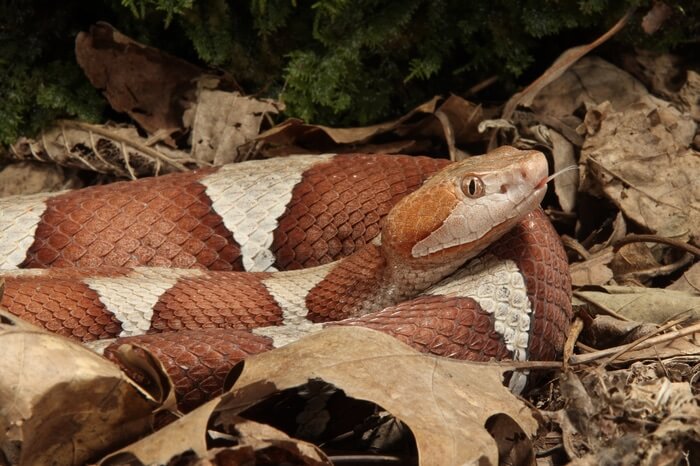
Other municipalities have similar laws. Killing a copperhead snake could result in steep fines and penalties. If you’re unsure of what to do with a captured copperhead, contact your local animal control department to see what they recommend.
Many places have specific guidelines to deal with venomous snakes like the copperhead.
Attempting to kill a copperhead snake could also expose you to some unnecessary danger. As we mentioned earlier, captured snakes are already aggressive and prone to biting. Adding some weapons into the mix isn’t going to make things any better!
Plus, you could end up hurting yourself trying to kill the snake! Copperheads are surprisingly fast when they flee. The last thing you want to do is try to chase one around with a weapon.
Finally, killing a copperhead snake could eliminate some of its potential benefits.
Now, copperheads are a considerable nuisance and can make your property unsafe. There’s no denying that you should do all you can to keep them away.
That said, getting rid of copperhead snakes entirely would do a lot of harm to the surrounding areas. Copperheads are like a natural form of pest control! They eat bugs and rodents that could otherwise ruin your yard and destroy your garden.
Quick Tip: We’re not saying you should let copperhead snakes roam free on your property, but you don’t have to kill them. Getting rid of them via catch and release methods relocate these snakes to nearby safer areas for both the snake and your family.
The best-case scenario is that the snake continues to control pest populations in the vicinity while staying out of your yard.
Keeping Copperhead Snakes Away In The Future
Getting rid of copperhead snakes in your yard will make it much safer for you and your family. That said, you have to be vigilant about keeping them out.
Quick Tip: Copperhead snakes can quickly return if you get lazy. These snakes are constantly on the hunt for food and shelter. The moment you let things go back to the way they were is when they’ll invade your yard once again.
To prevent future copperhead issues, adopt a routine of preventative measures.
Keep your yard clean at all times. Mow the grass regularly and pick up debris as it accumulates. Never let your property become a mess ever again. Otherwise, these snakes will move right back in!
It’s also a good idea to inspect your home regularly. Take a look around the perimeter and keep an eye out for any potential nesting areas. Seal up any holes or possible entry points to ensure that the snakes don’t get inside when the temperatures rise.
Finally, apply repellents regularly.
Use insecticides and rodent deterrents to keep copperhead prey out. As long as their food sources don’t return, neither will the snake.
Most products last about 30 days or so. Spread a new application once a month, and you can achieve year-long protection against these venomous snakes.
Does Snake Away Work On Copperheads?
Snake Away is a popular repellent that many use to drive out many snake species. Readily available at many stores, it’s widely accessible and easy to apply.
The product can work to keep copperhead snakes away. The main active ingredient (Naphthalene) does a decent job of messing with the snake’s senses.
It’s the same ingredient that’s found in mothballs. Essentially, it agitates the vomeronasal organ that snakes use to navigate their surroundings. When the vapors attack the organ, the snake can’t detect anything else. So, they turn away and avoid the area.
The science behind Naphthalene is inconclusive. It’s hit or miss, with some people finding success and others not.
Snake Away may provide results against copperhead snakes if used correctly. Apply it to your yard and pay special attention to your home’s perimeter.
Another popular product, Snake Out, may do an even better job of getting rid of copperhead snakes. Rather than using Naphthalene, it contains all-natural ingredients like cinnamon, clove, and cedar oil.
Like Naphthalene, those ingredients agitate the snake’s organs and make it difficult for the reptile to stay in the area.
The main difference here is the use of natural ingredients. Naphthalene can cause some complications if accidentally ingested by kids or pets. That’s not the case with natural alternatives.
For this reason, many recommend Snake Away alternatives that don’t use chemical ingredients. The best option for you depends on your lifestyle and safety concerns.
Final Thoughts
Now that you know how to get rid of copperhead snakes, it’s simply a matter of following our recommendations. These reptiles aren’t malicious and will move on if you give them a reason.
Stay calm, repel them properly (and respectfully), and your copperhead problems will be over!
